With BRT/LRT and better pedestrian streets, Hamilton could become a model city in the fight against congestion and poor planning.
By Jason Leach
Published December 13, 2006
Over the past few years, a shift has slowly taken place in Hamilton, one that recognizes the importance of a balanced transportation system and strong pedestrian environment in creating a healthy, livable, prosperous city.
RTH is a strong voice for safer streets and successful neighbourhoods in Hamilton. Recent discussions on our Hammerblog have shown the passion that exists in many corners of Hamilton to see the gradual shift in philosophy at City Hall translate into a shift in reality on the ground.
For several decades Hamilton's transportation planners have had one goal in mind - a city that allows for high speed car travel everywhere. Highways, major roads, downtown streets, retail streets, residential streets, it didn't matter. The ultimate goal was to shave every possible second from a trip across town.
The problem has now begun to show up in alarming fashion. Traffic congestion is growing rapidly in Hamilton and we're flush out of room for more highways or roadway expansions.
Current planners at City Hall have finally taken notice and are developing a Transportation Master Plan for the future that talks a great talk about getting more residents to walk, cycle and use transit as part of their daily lives.
Before I go any further I want to clarify two things.
Not every citizen wants to become a 'multi-modal' citizen. I realize there are some reading this article who will never step foot in a bus or train, regardless of how progressive Hamilton's transit system gets. That is your choice and I have no problem with it.
There are those who, upon hearing of transit and cycling improvements automatically assume that the goal is to create a gridlocked nightmare and get rid of cars altogether. Again, not true. Cars are here to stay. I own one and I use it. More importantly, gridlock is here to stay and will only get worse unless we fix the problem, and quickly.
Clearly the status quo is not an option. Without making any noticeable improvements to transit, cycling and walking options in recent years, our traffic is quickly congesting.
Those who oppose a balancing of our transportation system are actually a voice for more congestion, yet they speak as though balancing the system will create congestion. Hamilton has built new highways, widened roads and timed lights, yet congestion grows worse. Clearly that method is not working.
The recent transportation open house had a great piece of planning that was a welcome sight to people in attendance: a Bus Rapid Transit (BRT) system for Hamilton.
I believe that BRT, and eventually Light Rail Transit (LRT) is going to be a major component of Hamilton's future growth and prosperity.
This article is meant to stimulate discussion and ideas around implementing a full-scale, proper BRT system in Hamilton with an eye to a future LRT project being integrated into the system.
It is important to note three major benefits of developing a proper and efficient transit system.
Economic
Cities with comprehensive transportation systems always attract better jobs and of course, the employees that come with them.
The potential for high quality Transit-Oriented-Development (TOD) in both urban and suburban locales is almost always geared around rapid transit and proper urban planning principles (such as Westdale Village in Hamilton).
Urban revitalization. Cities have long been built around walkable communities with easy transit access. Hamilton's downtown core and neighbourhoods stretching east and north over towards Centennial Parkway would benefit greatly by an influx of new development.
Portland, Oregon has built a modern streetcar line in their downtown core to inter-connect with their light rail system. Since opening the streetcar line in 2001 it is estimated that over $2.3 billion has been invested in business development along the route. Not a bad return for a $54 million investment.
Kay Dannen of the Portland Development Commission: "since the streetcar opened for service, it has also helped facilitate over $2.3 billion worth of development and business. It's not only used as a transportation option" Dannen emphasized. "It's a huge economic development tool."
Health
Western nations are the most car dependent on earth. We own the most cars and drive them the most. Unfortunately, the sedentary lifestyle along with bad eating habits and polluted air and waterways has made us the most obese people on earth with very high rates of cancer, heart disease and other major ailments. Pollutions from our vehicles is a leading cause of our unhealthy air and water. We need to balance our options and not be completely dependent on cars as our only source of transportation.
Image
Image probably belongs in the same category as economy, but I'm putting it in its own category because I really believe it is that vital in attracting new residents and jobs to our city.
I recently met a young couple in my neighbourhood who had moved here from Quebec. Their image of Hamilton wasn't great, but upon arriving they both mentioned how the city's green cart composting program really gave the city's image a boost in their minds. The town they were from in Quebec barely recycled, let alone composted.
This is a small example, but still shows the importance of getting a fresh, new image of our fine city out to the rest of Canada. Safe, walkable communities with various methods of getting around are near the top of the list for many people, especially the coveted 24-35 age group that holds the keys to the future of our cities.
Image, as you will also see, plays a huge role in developing a new transit service in a city like ours. Buses have their image firmly planted in people's minds. The new era of BRT and LRT takes that old, dirty image and destroys it!
The Hamilton Street Railway has a long history of, well, street-level railway service. Much destruction of our transit system took place through the mid- and late-1900s; otherwise we might not be having this discussion today.
What's done is done and it's time to look to the future.
As I said earlier, the city's transportation master plan now includes a comprehensive BRT system. BRT is designed to act, look and feel like a LRT system, but obviously costs much less to build.
Standard components are:
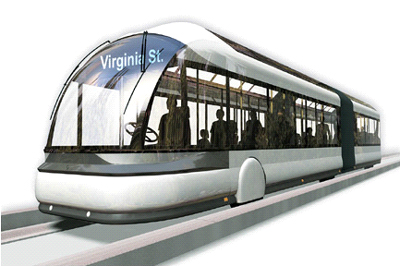
A nifty subway train? Nope. A modern BRT vehicle.
A BRT system in Hamilton would be comprehensive and include service across the entire city, including many suburban areas.
The city's long term strategy looks like this:
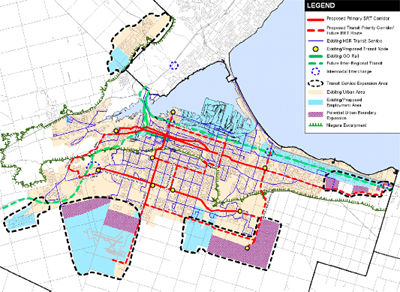
Red lines indicate BRT system
The first priority is the east/west corridor from McMaster to Eastgate Square. This corridor experiences incredible ridership levels, although there is much room to grow the service by adding a high-capacity BRT line here.
This east/west line is also the route I would recommend with planned conversion to a Light Rail line as we expand our BRT service.
Hamilton's first BRT buses are currently being built and a recently held design contest brought us a new design for these vehicles. Dave Kuruc of Mixed Media on James North was the winner and his design is sure to be a hit with the public when these new buses roll out in February 2007.
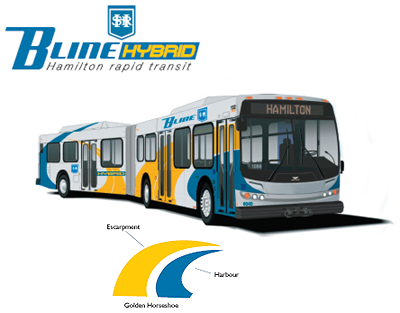
Hamilton's new BRT bus design
I believe we should work quickly to develop a basic BRT system consisting of three main lines:
All BRT service must be developed with full BRT components mentioned earlier.
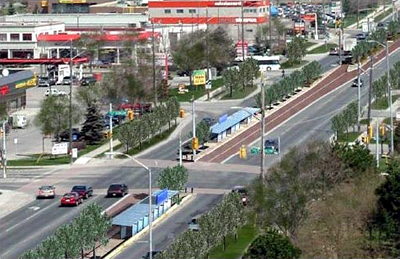
Imagine Upper James with BRT
A major component of modern BRT projects is the underlying fact that streetcars and light rail systems are far superior at moving large numbers of people than buses. Also, the image of rail travel is far superior to that of bus travel.
The economic spinoffs and TOD projects mentioned earlier have been far more successful in cities that invest in LRT. You'll recall Portland's numbers showing the level of private investment along a new streetcar route. Numbers like that are tough to find along bus routes.
That's where BRT comes in. BRT developers know and understand that rail is superior to buses and are responding with a host of brilliant initiatives aimed at giving BRT riders a rail-like experience.
In Hamilton, I would strongly recommend the following design of our Mac-Eastgate BRT corridor.
Purchase modern vehicles that look like trains.
Design stations with raised curbs so entry and exit is just like that of a train (see above photo of Upper James simulation)
.Have our BRT system become an electric system using overhead wires. This infrastructure can seamlessly be used with light rail in the future.
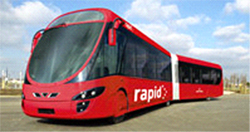
Rapid Bus in Austin, Texas
Routing and traffic flow: the envisioned BRT A-line would be most effective if both east and westbound service could be accessed on the same street for much of the route.
The only exception to this would have to be between Dundurn St and Macklin St until the King/Main 403 ramps can be rebuilt to accommodate two-way traffic.
Commencing at McMaster up the new front entrance and onto Main St using a median station design like the Upper James simulation above.
At Haddon Avenue the tracks would consolidate into one track and head through Westdale, with a stop in Westdale, to Macklin Street. Here the eastbound tracks would head south to Main and over the 403 to the Dundurn stop. The westbound tracks at Dundurn and Main would go north on Dundurn and west on King into Westdale.
Back on Main, both lines would travel in the centre of the roadway with median stations. There would be stops at Queen, Hughson, between Wellington/Victoria, Sherman, Gage, Ottawa, Kenilworth, Parkdale and Eastgate Square.
Main Street and King Street would become two-way streets with Main having two eastbound traffic lanes and one westbound traffic lane through the downtown area. East of the core where Main is currently four lanes there would be one lane in each direction. King would have one westbound traffic lane, one eastbound lane and on-street parking along both curbs.
The morning rush hour could see street parking banned in the westbound curb lane to allow for two travel lanes. Same would go for evening rush hour. All local bus routes that currently use King and Main would be routed both ways on King.
The exception to this could be the #5-Delaware which could remain in its most common route using Stinson, Delaware and Maplewood.
Hamilton is blessed with an abundance of streets to move around the city. Having King and Main two-way would provide more options for travel and would allow for special events downtown on King St without disrupting the BRT service.
Cannon, Wilson and Barton are also major east/west streets within a few blocks of King and Main. Automobile traffic flow would be slightly slowed down on King and Main with this plan, but would end up dispersing across both streets with the two-way system in place.
Right now Main has between three and five eastbound lanes through the city. King has between two and four. This plan still allows for between two and four eastbound lanes with two or three (rush hour) westbound lanes.
We're losing a grand total of one lane each way, but adding in the all important rapid transit system we so desperately need.
Remember, the goal is not to get rid of cars or cause congestion. The goal here is to provide comfortable, reliable, convenient options for Hamilton commuters.
Hamilton is blessed to have a very compact urban corridor in the lower city. Exact figures aren't easy to come by, but I have no doubt that a rapid transit system in this east/west corridor would result in less east/west car trips being made by folks who live in the Westdale-Eastgate corridor.
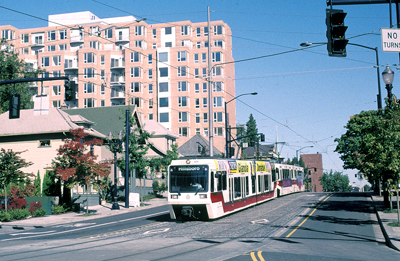
Main Street LRT - 1 lane westbound, 2 LRT lanes, 2 lanes eastbound.
The beauty of developing a full and proper BRT system as proposed here is the ability to lay track and convert the lower city A-line to our first A-Train. Extensions could be built southeast into downtown Stoney Creek and westward along Main West from Mac to Dundas.
Austin, Texas is currently planning a new light rail along with many new BRT lines as a well-planned, comprehensive transit system. Hamilton should do the same.
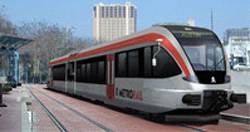
LRT vehicle in downtown Austin
Station design along Hamilton's BRT route would be more than suitable for use as LRT stations in the future as both modes of transit are very similar and aiming to achieve similar goals.
Perhaps in the future, BRT technology will equal that of rail, but for now, rail is still far superior and would have a greater impact on Hamilton's urban neighbourhoods.
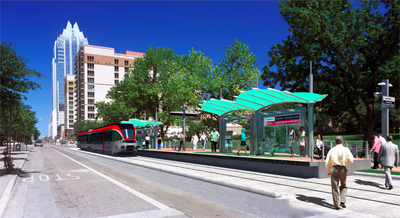
LRT station in downtown Austin
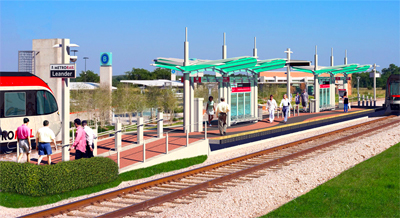
LRT Station in suburban Austin
As you can see from the above photos, LRT/BRT stations are not large and can easily be accommodated in the urban environment.
Building raised platforms like this along Main Street would allow for easy conversion to LRT in the future.
Using cost estimates of $25 million per mile for LRT systems, Hamilton could build the 8.5 mile light rail system between Mac and Eastgate for $200 - $250 milliion. BRT of course, would be much cheaper.
For comparison sake, the Red Hill Expressway Project is now budgeted to cost $440 million. Also, by building proper stations for our BRT system we will be spending a big chunk of the money up front.
The next large cost down the road would be for adding track. This is doable for Hamilton and the senior levels of government would be large funding partners.
Ottawa is currently building a light rail system and has 95 percent of the cost covered by the province, feds and gas tax monies. Hamilton, with a sound plan, could also receive significant government money for such a project.
The future seems to be endless for this sort of transit system. Sleek new BRT vehicles are becoming more and more common. Along with better pedestrian streets and more bike lanes throughout the city, Hamilton could become a model city in the fight against congestion and poor planning that plagues so many cities.
Our new mayor had very specific and timely campaign promises regarding balancing our transportation system. There will always be a few naysayers who would rather see Hamilton remain stuck in a slow (or even 'no') growth mode with many of our young, bright minds leaving for better cities. But proper planning and sustainable city-building have long been proven to work in any city, any climate and any nation.
The time for looking back and longing for the past is gone. We can learn from our past as Hamilton looks forward to build a top-notch transit system that can become the catalyst for renewed urban growth, redevelopment and prosperity in our city.
Hamilton could eventually see a 'loop' line running along Hwy 403, Main St, Hwy 20 and the Linc with stylish, Wi-Fi, comfortable, speedy 'bus-train' vehicles zipping through our city and drastically improving the quality of life and economy for everyone.
By Joe (registered) | Posted December 14, 2006 at 00:15:18
I wish people at City Hall could get as excited about these ideas as some of the RTH authors.
Just an idea: imagine a BRT line tailored to Hamilton's unique geography--first city to have a BRT incline (like the old incline railway). Now that would be something.
Thanks for yet another informative and inspiring article.
By aaron (registered) | Posted December 14, 2006 at 00:57:17
Excellent article...these are some great ideas. I think that the simplest, most practical and realistic short term idea mentioned is to pay attention to image. Differentiate BRT from regular buses by having little "stations". It shouldn't be too expensive or difficult to have little raised platforms, distinctive logo and shelters. Make it cool to ride the BRT and if that is successful, it could lead to bigger improvements like light rail.
By Randy Park (anonymous) | Posted December 14, 2006 at 09:28:31
Right on! Living in Toronto, I see all the debate about ridiculously expensive subways, when all we really need is the will to take just _some_ of the land devoted to cars and convert it to transit use. And it's really simple math - lose one lane of traffic and replace it with a vehicle which will carry 60 people, taking roughly 4 blocks of traffic away. Everyone, including drivers, will move faster.
All it takes is forward thinking and willpower.
www.EnergyPredicament.com
By kevin (registered) | Posted December 14, 2006 at 10:09:49
Great piece, Jason.
You're right on the money again.
Have you ever considered putting your name on a ballot?
By Doug Price (anonymous) | Posted December 14, 2006 at 23:18:49
I was raised in Hamilton in the '50s now living in greater Vancouver. Please, do NOT go with "at grade" rapid transit. I have ridden on that system in Edmonton and it does not compare well at all with Vancouver's elevated Sky Train, Seattle's monorail, or Toronto's subway. Think of a high speed street railway with tens of level crossings interfering with vehicular traffic flow. Vancouver's system flies above the traffic, not interfering with it and as a bonus offers spectacular views of the city to passengers. A subway offers the same advantages without the view, out of sight, out of mind. As a bonus, tourists love it.
By jason (registered) | Posted December 14, 2006 at 23:25:48
hey Doug...good comments. You're certainly right about the advantages of keeping transit separated from other crossings. I think this highlights the importance of developing a BRT or LRT system that has control over traffic signals and also has its own lanes. I'm not proposing anything like Toronto's streetcars which sit in traffic. In Hamilton the money and political will does not exist to build a monorail. Our population isn't dense enough to support subway (and again, money is a problem). I've ridden light rail systems that have their own lanes through urban downtowns and like the experience of seeing the city. Also, when walking along a sidewalk they add a nice level of urbanism as they quietly glide by. Centre lanes with a centre median is my preferred choice in Hamilton to avoid using curb lanes where people are trying to turn into parking lots or side streets. Vancouver is a gem of a city. We can learn from them in many ways....but we've got to adopt to our own geography and political climate on certain issues. Cheers
By linda parker (anonymous) | Posted December 15, 2006 at 00:22:46
It would be very interesting to have buses like that in Hamilton. It would make the traveling a lot faster.
Linda Parker
By jason (registered) | Posted December 15, 2006 at 09:43:01
hey, what do you know? I just came across this website with a great piece on Hamilton planning a BRT system and eventually an LRT system. Cut and paste this into your browser:
By Paul (registered) | Posted December 15, 2006 at 13:33:17
Jason,
Great article. I think you should apply to be on the Transit Master Plan Steering Committee. We are working to get BRT implemented in stages starting with an enhanced Beeline. It's a great opportunity to put your ideas into practice and we need as many rapid transit advocates as possible.
-Paul
By Bob (registered) | Posted December 19, 2006 at 00:01:28
Jason Leach is cheerleader for theoretical ideas. Better study the budget and figure out what is affordable, Portland example notwithstanding. Hamilton in Canada is not Portland in USA, economic engine of the world (at present).
1) Hamilton is a city in name only. Not dense enough as Jason reminds us above. Just another suburb save a few blocks in core. Storefronts barely viable anywhere but in BIA's. Bulldoze the whole thing!
2) Hamilton has no viable tax base. Steel is dead/dying (or should be as it would release redevelopment per US rustbelt). Rest is services, government and overtaxed residential (all dependant on primary). Dormitory town. Bulldoze the politicians!
Then again, politicians just reflect the voters.
JIMHO :-)
By aaron (registered) | Posted December 19, 2006 at 07:27:58
Bob, you can't seriously argue that Hamilton is just a dormitory town or suburb, and even if it is, they still need transit. And for what it is, the lower city is far denser than similar sized cities in Canada, current east-west buses are at capacity and BRT would certainly be viable and could be an important tool in making the city healthy. BRT would have similar economic benefits for less cost than Red Hill for example. As much as people point out the decay of the lower city, it's not nearly as bad as what you see in the US, and cities in the US have successfully revitalized, many of them building some form of rapid transit.
Hamilton does have many empty storefronts, perhaps better transit would help fill them. Barton St. for example, had lots of stores when streetcars ran (not saying that's why the stores closed). You might also look at Ottawa St and Locke St, which are doing quite well and would also have better links to other parts of the city if BRT were implemented.
By jason (registered) | Posted December 19, 2006 at 19:05:21
a few points to add:
Cheers
By highwater (registered) | Posted December 21, 2006 at 12:24:37
Unfortunately, Bob's second point about Hamilton's lack of a viable tax base is true. It is worrisome that our largest employers are now government (ie. health care and post-secondary ed.). It will be very difficult to expand the tax base in the foreseeable future. This is not necessarily insurmountable, but it does need to be recognized. Yes, money was found for Red Hill, but then there were vested interests involved weren't there? A level of political and community will that Hamilton has never seen before will be needed push through these changes.
By Rudy Schwartz (anonymous) | Posted December 23, 2006 at 11:05:47
Nice article. As a resident of Portland considering a move to Canada, it's interesting to see your perception of Portland. I happen to think it's the most livable U.S. city by a long shot, and it's the one thing that would be likely to keep me in a country governed by unspeakably stupid men. I would throw out one comment, however. While I understand the advantages of two way streets for calming traffic, it's worth noting that most of Portland's downtown consists of one way streets, and it's extremely amenable to pedestrians. In fact, one of the most difficult streets to cross is Burnside, which is two-way. The key, I think, is to not have freeways disguised as streets running through your downtown. Perhaps reducing the number of lanes by adding BRT/LRT lines and wider pedestrian paths with lots of trees would accomplish your goals, while still maintaining the advantages of one-way streets for normal downtown driving. And by normal, I don't mean whizzing through downtown to commute from suburb to suburb. That should be discouraged, and the only way to discourage it is to make it a pain in the ass. Good luck with your city. You have some good ideas.
By schmadrian (registered) | Posted December 23, 2006 at 21:23:54
This may not be entirely on-topic, but I thought I'd throw it out there, though I'm bringing up transit as it now exists.
Has anyone else noticed the issue of how HSR's buses do not reflect the needs of three sectors of its users?
1) Parents with buggies 2) Riders with 'walkers' 3) 'Wheelchair-esque' users.
I seem to have spent an inordinate amount of time this month on buses, and I'll tell ya, I've been absolutely gobsmacked by how bad the fit is. It's like nobody forecasted either the increased use of these three items or their designs and how ease of access on the buses is so badly impacted. Never mind the fact that people seem absolutely contrarian when it comes to moving to the back of the bus (today on one of my trips, while the front was congested, there were FIVE seats at the back!), you get two walkers, two prams...and whatever joy's inherent in 'going mass transit' is gone. The passengers get crabby, the drivers get crabby...and it's not just because it's Christmastime.
I'm just sayin'...
By schmadrian (registered) | Posted December 26, 2006 at 06:15:43
Here's a question for you: is there any municipality anywhere, anywhere at all in the world that doesn't charge for public/mass transit? Who views getting around in an ecologically responsible way as a 'God-given right'?
Just curious as to how much impact you'd have on an economy if you provided this. I mean, if you're going to make responsible transit such a priority, why not go the full nine yards...?
By jason (registered) | Posted December 26, 2006 at 09:47:14
I could find out if any cities offer free transit everywhere, but I do know that Portland and Seattle have large 'fareless' areas where transit is free...both cities have these zones in the downtown area and immediately surrounding neighbourhoods....it would be similar to Hamilton saying 'transit is free' from Hwy 403 to Ottawa Street or thereabouts....a large enough area to have an impact, but not the entire city. It was a quite a shock to my system when in Portland and Seattle to be hopping on buses and trains for free. I'm sure in Europe there must be cities that have free transit....anyone else know??
By schmadrian (registered) | Posted December 26, 2006 at 12:52:35
Well, I've often felt that we're living in a closed-loop where it comes to 'mass transit being the solution, where the automobile is the problem'.
That is, you cannot (as in 'The Government') insist that people begin to take an entirely different approach to 'getting around' unless you provide a viable alternative. It's pointless, it's silly...and it's either naive or arrogant, take your pick.
Until we have a breakthrough regarding non-petroleum-based cars(never gonna happen, not with the oil cartel having so much power as to be able to effectively declare wars; the only thing that's ever going to force a change is for us to run out), people have to be enticed to using transit. (Even if it's just as an auxuillary to their family car.
And you know what? No matter where I've lived (Canada, UK, US), I've never seen an integrated system that works. More precisely, a system that's a sufficiently enticing one as to get people out of their vehicles and onto transit.
The start here, is to provide service that not only meets needs, but draws people away from the default, their car. (Keep in mind throughout anything I say that the goal here is not just to provide an alternative, but an enticing one. It has to supercede to a certain level what the car provides. And seeing as the car has suah an enormous value both in personal validaiton and for men, as a pnis extension, we're talking a huge task.) So for Hamilton, you need coverage, you need scheduling and you need integration. You don't want me commuting in my car to any point north of the city? Fine; make me an offer to keep me off the highways. I can't believe that regional integration has been so long in coming...and it's still not really there. (I'm actually *not surprised; this is prof-positive of how entrenched the value is of 'the car' in our society. It is, no other way of putting it, insidious. Having returned to North America recently, I'm all the more aghast at how the automobile dominates television advertising! I'll save the meat of this for an article, but how did we ever end up placing so much importance on an item whose only real purpose is to get us from Point A to Point B?!? This is, in my view, astounding.)
The second aspect of enticement is the cost. I look at monthly passes here, in Toronto, in the UK...and what strikes me is that the authority providing the service (and therefore, 'the deals) looks at things bassakwards. Or, not to put too fine a point on it, they're not looking at it with the same value system in mind as someone might, were they trying to effect a paradigm shift away from cars, trying to 'entice' people to 'a better way'. And therein lies the problem. As long as we look at transit as a 'money-maker', we're DNS/DNF. The closed-loop I mentioned.
The third part ties into the first two, but from the other side of the equation: the passenger's interest in making that paradigm shift. Somewhere along the line, people have to want to do what's right, travel, commute, locomotion-wise. As fresh generations are introduced into society, there is a mindset-shift. (Or at the very least, the possibility of one; look at recycling, or even healthier eating attitudes. Can you imagine either of these to aspect of modern living being given the focus they are by today's younger generation, by their parents or grand-parents a quarter-century ago? Change is possible in an attitudinal sense, but it takes enormous awareness...and initiative.)
Again, I see Hamilton as having an enormous opportunity here. The possibilities are incredible when it comes to building a transit system that's remarkable in its scope, its attitude towards sustainability, and the shift in attitude about what the 'default' is where getting around is concerned. But it would take some truly visionary thinking to get the ball rolling, to begin looking at how things could be in the area. Because so much needs to be addressed/fixed here, we're in the enviable position of having all manner of options open to us. (Unlike Toronto, for example, where they're very much locked-in to what they've put in play over the past forty years.)
Come on, people! Not to get all trite on everyone, but we really need to think outside the box. If you want something truly exemplary, and I'm sure Hamiltonians do, or would, if they were encouraged to dream more, then you have to think in exemplary ways.
Or, to put a more realistic spin on things: we're all part of the problem, there's no reason we can't all be part of the solution.
Here's to more exemplary visioning in 2007.
By free transit (anonymous) | Posted June 12, 2010 at 19:12:29
Just google "freepublictransit" to connect with the international campaign, or go to freepublictrans on twitter.
You must be logged in to comment.
There are no upcoming events right now.
Why not post one?